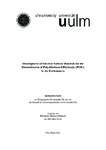| dc.description.abstract | This cumulative thesis aimed at the investigation of alternative sorbents based on
molecularly imprinted polymers (MIPs) and multi-walled carbon nanotubes (MWCNTs)
for monitoring of polychlorinated biphenyls (PCBs) in various environmental matrices.
The first section of the thesis is the general introduction, where the concept of molecular
imprinting and the three main imprinting approaches are discussed. The non-covalent
imprinting approach owing to its simplicity and availability of functional monomers is the
preferred approach, and was exclusively applied in this thesis. The emerging term “class
selective MIPs” for simultaneous recognition and detection of a group of similarly
structured compounds is also discussed, and was adopted during these studies. The
current knowledge on use of MIPs and MWCNTs in sample pre-treatment and the need
for validation of affordable analytical protocols for monitoring of PCBs is discussed.
Facts about PCBs are presented, and the particular concern about PCBs in the Kenyan
environment is discussed with a view of identifying the existing technology gaps, as far as
their monitoring is concerned.
The second section contains the 4 papers that make up this thesis. Paper I sought to
develop a reliable and affordable column for clean-up of extracts during the
determination of PCBs in complex matrices. Thus prepared cartridges based on MIPs
were successfully applied for the quantification of PCBs in sediments and soil. Motivated
by the performance of the cartridges and their re-usability, further determination of
PCBs in soils from various solid waste disposal sites and sediments from a second river
was achieved, and the results are included at the end of Paper I. Paper II introduces two
different strategies for imprinting of PCBs based on chlorinated benzene and xylenes
serving as porogenic templates, whereby porogenic fragments present a particularly
attractive option for chlorinated compounds. Paper III discusses the potential of using
MWCNTs as sorbents for the quantitative pre-concentration of PCBs from aqueous
samples. Thereby, it was established that these sorbents work well with highly chlorinated
constituents, and may also be applicable in water purification, yet only in the absence of
oxidizing agents. Paper IV is a review on strategies that have been applied to synthesis
polymers selective to polychlorinated aromatic compounds (PACs), and subsequent
application of these polymers in determination of PACs in the environment. | en_US |

